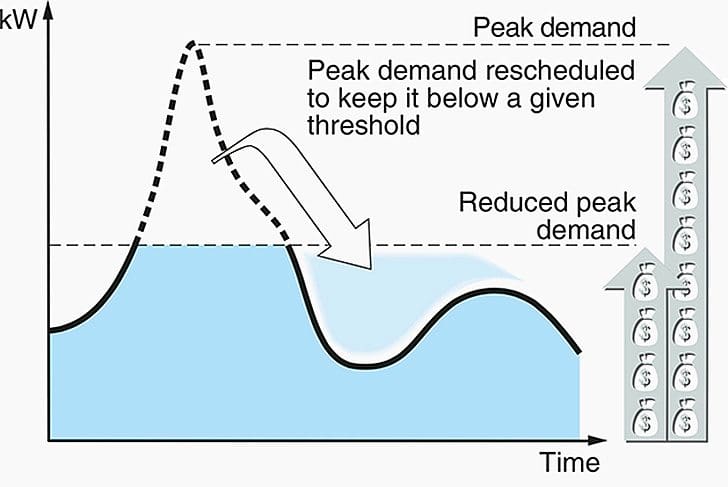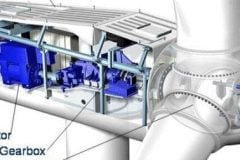How utilities understand the loads…
As part of their drive towards synchronizing the consumption and production of electrical energy over the long term, energy distribution companies tailor their rates to encourage consumers to reduce their requirements during peak periods.

A number of different strategies are possible, depending on consumption levels and operating requirements: restricting demand (see Figure above), avoiding peak periods, load scheduling or even generating additional energy on site.
Let’s see the each of stated strategies:
1. Demand restriction
Energy distribution companies can use this solution in supply contracts containing optional or emergency (involving compulsory limits) restrictive clauses whose application is determined by the consumer (based on special rates).
Reducing consumption in this way can prove problematic in residential and service sector environments, as they may considerably inconvenience building occupants. Customers from industry may show more of an interest in this type of scheme and could benefit from contracts reducing unit costs by up to 30% if they have a high number of non-essential loads.

2. Peak demand avoidance
This method involves moving consumption peaks in line with the different rates available. The idea is to reduce bills, even if overall consumption remains the same.
3. Load scheduling
This management strategy is an option for companies able to benefit from lower rates by scheduling consumption for all their processes where time of day is neither important nor critical.
4. Additional energy generation on site
The use of generating sets to supply energy improves operational flexibility by providing the energy needed to continue normal operations during periods of peak or restricted demand. An automated control system can be configured to manage this energy production in line with needs and the rates applicable at any given time.
When energy supplied from outside becomes more expensive than energy generated internally, the control system automatically switches between the two.
How customers understand the loads…
A company’s (or anyone’s) electric bill, in most countries, consists of two major components:
- Demand charge and
- Energy consumption charge.
Demand charges are reset monthly and are based on the highest rate at which electricity is consumed during periods that are peak utility service hours. Demand charges are measured in kilowatts and, depending on the utility service provider, the highest consumption rate is measured in 15- or 30-minute intervals during peak hours or contracted value.
Demand charges form a significant portion of a company’s monthly electric bill.
Peak load management strategies that lower a facility’s demand during times when the peak demand is measured can result in significant facility cost savings, especially for commercial, industrial and governmental sectors.
Smart load management – Smart customer
Smart electrical load management solutions are designed to gain advanced control and minimize cost. They include applications to help reduce downtime, reduce energy costs, support capacity planning, improve efficiency and provide a view into the system as a whole.
Electrical load management solutions generally help to:
- Avoid excess demand charges by reducing peak demand
- Lessen the impact of utility power outages
- Reduce power factor penalties from the utility company
- Reduce the negative effects of poor power factor or high harmonic content
- Automatically control on-site generation and secondary systems
- Control an industrial electrical distribution system with minimal staff
References:
- Electrical Installation Guide 2015 // Schneider Electric (Download Guide)
- Load Management System Using Intelligent Monitoring and Control System for Commercial and Industrial Sectors – M.M. Eissa, S.M. Wasfy and M.M. Sallam
- Power and Energy Management Solutions – Rockwell Automation, Inc.
Copyright Notice
This technical article is protected by U.S. and international copyright laws. Reproduction and distribution of PDF version of this technical article to websites such as Linkedin, Scribd, Facebook and others without written permission of the sponsor is illegal and strictly prohibited.© EEP-Electrical Engineering Portal.
Related electrical guides & articles
Premium Membership
Edvard Csanyi
Hi, I'm an electrical engineer, programmer and founder of EEP - Electrical Engineering Portal. I worked twelve years at Schneider Electric in the position of technical support for low- and medium-voltage projects and the design of busbar trunking systems.I'm highly specialized in the design of LV/MV switchgear and low-voltage, high-power busbar trunking (<6300A) in substations, commercial buildings and industry facilities. I'm also a professional in AutoCAD programming.
Profile: Edvard Csanyi








hello Edvard.
How to become like you? so knowledgeable!! Teach me please.
A very good article on energy management system.it’s very informative…